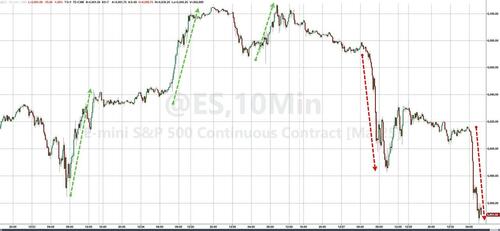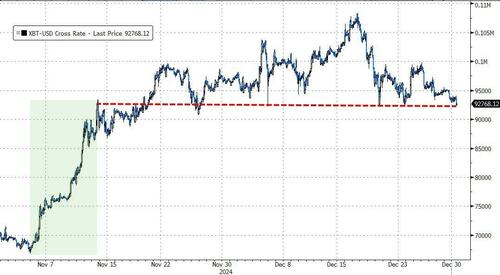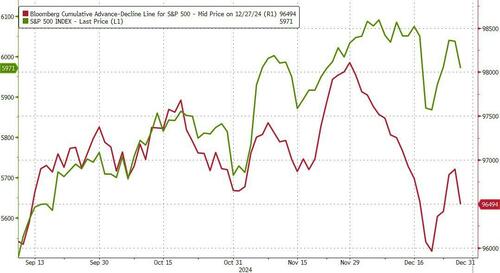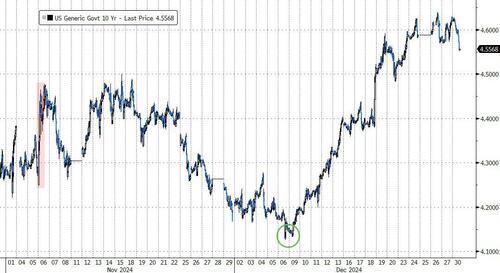2025 Will Be…
Authored by Peter Tchir via Academy Securities,
2025 Will Be…
A week ago, who would have thought that there would be anything interesting to write about concerning markets on December 29th? A short trading week in the U.S. and an even shorter one in Europe. Even Academy guest hosting Bloomberg TV (first hour) seemed unlikely to move markets.
Everyone seemed pretty settled in for the Santa rally, which was delivered last Friday, Monday, and Tuesday. But a funny thing happened on the way to cruising through to the new year – a solid 1% loss on Friday for the S&P 500 and Nasdaq 100.
When we have been discussing the year ahead, primarily thinking about potential policies from the Trump administration, we’ve often used the word “chaos.” While I don’t think that 2025 will be chaotic, at least not for markets, I do think that 2025 will be messy.
More to the Story than just Interest Rates
We will come back to rates, which we addressed somewhat in last weekend’s The Darkest is Behind Us (which is a fact since Dec. 21 is the shortest day of the year for many of those who read the T-Report).
We highlighted in that report that we are paying attention to the price of Bitcoin.
Of all the markets out there, crypto in general and Bitcoin in particular seem to be heavily influenced by the potential that the Trump administration will adopt some form of Strategic Bitcoin Reserve (which I think is an insane idea, but, as we’ve been discussing, it could happen).
While not a “pure play” for the Trump administration, it does, I believe, give us some insight into how markets are thinking about the likelihood of policy getting through. Yes, this is a very specific policy, but since the administration hasn’t even officially begun, there is some signal value to all the noise around Bitcoin. Bitcoin is back to around $95,000 (at the time of writing this, so it could be anywhere within 5% of that by the time you read this).
It has struggled since the “budget debate” took place – largely on Twitter/X. We argued that you should Pay Attention to the Budget Debate This Time, because it gave us some insight into how this administration is likely to work.
The result was far from clear. The initial/very long bill, with a lot of spending, got replaced by a smaller bill, with a lot less spending. That bill failed to pass. Then something passed, that was much shorter than the original bill, but it was far from clear where it came out on spending (remember, Democrats all voted for that version).
Now, somehow, Twitter seems full of “information” about H-1B visas!
President-elect Trump seems very quiet on the subject, but other members of his team are quite vocal about it and seem surprised by the “noise” around this topic. I too am somewhat surprised about how this story is playing out, but it certainly fits with our view that this administration is likely to be chockfull of messy and even chaotic moments! It is the nature of the people involved and their media platforms of choice.
While Friday’s move in stocks was likely, in part, a delayed reaction to the recent move to higher bond yields, I think it is also a symptom of a growing concern that the market won’t get all of the positive policies that it has been pricing in, at least not right away!
A lot (that might not happen) has been getting priced in.
Breadth Also Points to Doubts
The S&P 500 is down 1% in the past month. But only 81 stocks are up and 426 are down in this period (there are more than 500 stocks for a few reasons).
Sure, with the index down 1% you would expect more down stocks than up stocks, but more than 5 times as many losers than winners?
Just how many stocks are struggling is interesting. Either we get policies that benefit the market as a whole, which should provide nice gains for those stocks, or whatever flows are driving the chosen stocks may dry up?
TSLA is the number 2 performing stock in the past month. It is off the highs of a couple of weeks ago. Nonetheless, it is up 77% since November 4th. At least some part of the price move is likely coming from the view that Musk’s companies will benefit from his position in the administration. It seems like a plausible assumption (just as it seems plausible that Trump will be a big benefactor for the crypto community, which did a lot for his campaign). Will that last?
Will that continue if the administration gets messy or even chaotic?
One stock does not a market make, but with breadth so poor, it wouldn’t take much shine coming off of any of the big winners (there are about 20 or so stocks up from 5% to 51% in the past month) to really move the needle.
I am worried that disappointment, while getting priced into individual stocks, has not been priced into the indices, and there is more downside if that occurs (which seems more likely right now, rather than the laggards getting huge gains in the coming weeks).
I Cannot Rant Enough About Single Stock Leveraged ETFs
MSTX is high on my list of things that I check daily (a double leveraged ETF referencing MSTR). Leveraged ETFs always have a negative drag over time. This drag is due to the cost of funding the positions, and the rebalancing. Every day the underlying asset goes higher, they buy more, and on every down day, they are forced to sell. Since June 18th, NVDA is up 1%, but NVDL (a leveraged ETF referencing NVDA), is down 19%. I only bring that up as it highlights the drag effect that anyone “investing” via leveraged ETFs faces.
I brought up MSTX because almost any asset manager I know would be ecstatic to get inflows while producing awful returns. MSTX is down over 60% since Nov. 20th, but has seen its shares outstanding almost double since then (an increase of 85%). The market cap/AUM of MSTX has dropped from more than $2 billion to just over $1.5 billion. However, this is not from investors exiting the ETF. As new funds keep coming in, this causes new shares to be created to absorb that demand.
Maybe I’m just old and cranky (I am both), but this seems like “frothy” behavior to me. Even if the thesis is “correct” that Trump will support Bitcoin, playing it through this particular vehicle (a double leveraged ETF) seems like an extremely aggressive way to put your money to “work” (if nothing happens, over time, the drag effects erode the value of the ETF).
Banana Republic?
We will take a more serious look at yields in a moment, but I want to highlight two things that may not be helping bonds and are not getting any/much attention.
-
Borrowing to buy Bitcoin. While some segment of the population (namely existing Bitcoin “champions”) relish this idea, it is possible that some bond investors would view this as an irresponsible use of money by the government. Yes, I know, we will all regret not doing it when Bitcoin hits $1 million per coin (according to some pundits). But for many, including me, the fact that we are even discussing this gives me bad vibes about the future path of our debt.
-
Annoying Bond Buyers. While Greenland and the Panama Canal are unlikely buyers of Treasuries, Canada owns $365 billion of Treasuries as of the latest TIC data. That puts it in the top 5 below Japan, China, the U.K., and Luxembourg (I think Luxembourg acts as an “intermediary” for other holders, which seems a bit weird, but is how the system works). Canada (the 51st state with a “governor” rather than a Prime Minister) and China have both been front and center with Trump. So far, I think the U.K. enjoys some sort of “special relationship” with Trump, but the rest of Europe seems to attract some negative attention. There are all sorts of reasons why foreigners need to (and want to) hold Treasuries, but there does seem to be some risk that creating “fun” talking points domestically might not be helpful in the long run.
I don’t think that these are big issues, and I almost didn’t include this section, but my gut tells me that I want to be on the record, early, on this potential risk. Bond investors do not thrive on chaos and messiness.
Bond Yields
Two pieces of data that I’ve seen a lot of, in the past week, tell very different stories:
-
Apparently, after revisions, Q2 of 2024 is likely to show job losses rather than gains, once all the revisions are put through. That would argue for a more aggressive Fed, as the job market may be worse than the data that the Fed has been basing its decisions on suggests.
-
Health insurance, according to CPI data, is down 32% since the end of 2022. This number seems completely wrong. While OER (Owners’ Equivalent Rent) is so convoluted, it is difficult to laugh at (it tells you far more about past events in housing, rather than current events). However, I cannot think of one conversation that I’ve had in the past two years being about how attractive health insurance premiums and deductibles are. Not one. Zero. Nada. So, when we look for reasons why people aren’t as happy with the progress on inflation, as the Fed and many economists seem to be, this might be a good thing to point to. I have no idea how this is calculated (and it is certainly “correct” based on how it is calculated), but it doesn’t seem to reflect reality.
But enough on that, for now, since other than providing two examples of how tricky (and fickle) the data might be, it doesn’t explain how we are now down to 1.5 cuts being priced in for all of 2025!
It has been a while since my base case had more rate cuts than the market was pricing in. For much of the last two months, we have been arguing that the market was way ahead of itself, as we felt 2 or maybe 3 cuts was all that was left for the Fed going into 2025.
Low liquidity, year-end issues, etc., make it a bit more difficult to say with any degree of confidence that the market really is thinking just over 1 cut next year, but that seems to be the direction that we are headed. Presumably, this is driven mostly by concerns about inflation, comfort on jobs, and a little concern that Powell’s “reaction function” may have changed post-election (I don’t think it has, but that theory is certainly out there and has helped move markets).
The long end is clearly being impacted by fears about our growing deficit.
By fears about how much debt is maturing and will be rolled over at higher interest rates. At a glance it looks like $2.6 trillion of coupon debt is maturing between now and the end of 2025. The average coupon is 2.56%. If that debt gets rolled over into new debt with, say, an average coupon of 4.25%, that takes the interest expense on that debt from $68 billion annually, to over $113 billion (even in D.C. $45 billion seems like a lot of money, especially when it is just to maintain the status quo).
We argued that yields going above 4.4% after the election was overdone. That positioning was too bearish and too many negatives were being priced in on bonds. They peaked at 4.45% (on a closing basis) and then came all the way down to 4.15% on a closing basis (within the range we had hoped for).
Since 4.2% (not the bottom), we have been arguing that yields would push higher and had 4.4% to 4.6% as a “fair” range. We are currently sitting at 4.62% on 10s. 2s vs. 10s, which we thought should get to 25 bps, is now at 29.
So, with 10-year yields above our range, and 2s vs. 10s having moved quite nicely, we have two choices:
1. Stick with our ranges and turn bullish on bonds.
2. Raise our ranges and remain bearish.
While bond yields could do well in the last two trading days (month-end extensions for index buyers, and possibly some bond vs. equity rebalancing), it seems like we need to move our bond yield targets higher.
Nothing that I’ve written today (except for the Q2 job revisions) gives me any comfort in buying bonds here. Yes, positioning is getting back to being a bit too bearish, but it does not seem/feel (as vague as that is) as negative as it was just a month or so ago (as many people are justifying buying here as selling). Underweight duration, while a commonly held view, doesn’t seem to be the universal view. I think there is more room to run and think that we can get to 4.8% or higher early in the new year. We should see a glut of corporate issuance, which while great for Academy’s business, is not so great for bond yields. Again, we might see a nice little bounce in the next couple of days, but the move to higher yields should continue at the start of the new year.
Bottom Line
Messy is manageable, chaos is not.
Expect choppiness and the occasional “rug pull” given the potential news flow from this administration. It may all still work out. I remain a believer in “Refine Baby Refine” (we need to not only extract a lot more minerals and rare earths, but we also need to process them). The competition of chips, AI, and tech will also create a lot of opportunities. Tax cuts, while bad for the deficit, would be a big boost to the economy. The ending of wars would also be great.
There is a lot to look forward to, but the markets seem to have gotten ahead of themselves, and while the bulk of the pain in Treasuries may be over, the same cannot be said for equities, from my perspective. A lot of “Santa rally” trades could be in jeopardy in the coming weeks, as the insights we will get into D.C. policy making are likely to be messy.
Thank you again for all of your support for Academy Securities in 2024 and we are really looking forward to 2025 (even if it might be a bit messy)!
Tyler Durden
Mon, 12/30/2024 – 10:25





